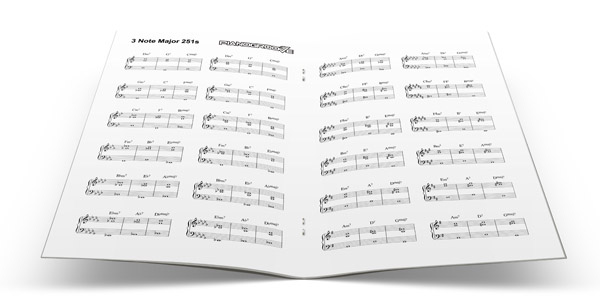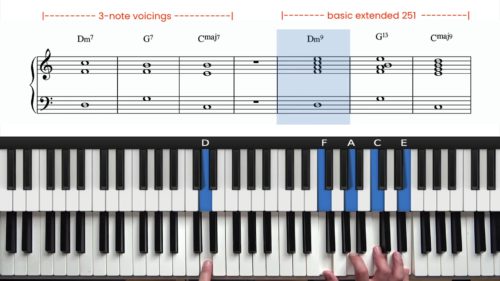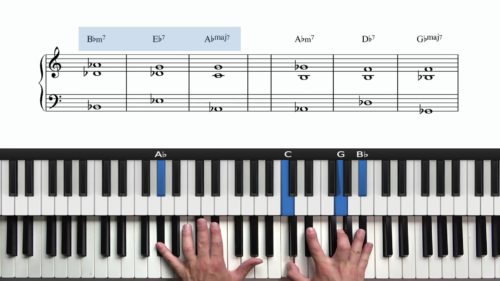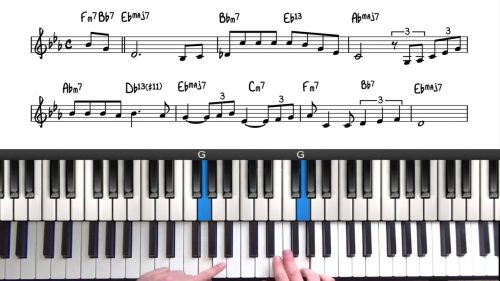Major 251 Progression Tutorial
Welcome to this foundational lesson where we explore one of the most essential progressions in jazz harmony—the major 251 progression. If you’re new to jazz piano or building your harmonic knowledge from the ground up, mastering 251 progressions is a critical step forward.
This lesson will guide you through building, voicing, and understanding major 251s using simple and effective 3-note voicings. These voicings provide clarity, solid voice leading, and a smooth transition between chords, helping you sound more musical and confident when playing from lead sheets.
Why Is Learning The 251 Progression Important?
The 251 progression is often referred to as the DNA of jazz. It appears in almost every jazz standard and learning to recognize and play it fluently is key to understanding jazz harmony. A major 251 consists of a minor 7 chord, a dominant 7 chord, and a major 7 chord—built from the 2nd, 5th, and 1st degrees of the major scale, respectively.
For example, in the key of C major, the 251 progression is:
-
D-7 (ii)
-
G7 (V)
- Cmaj7 (I)
We break this down in three keys: C major, D major, and Bb major to ensure you can apply this progression across various contexts.
Downloadable Lesson Supplement
The first step is to learn and memorise the major 251 progression using the 3 note voicings found in this lesson supplement:
251s & 3-Note Spread Voicings
Rather than playing root position chords, jazz pianists often use spread voicings. In this lesson, we construct 3-note voicings using the root in the left hand and the 3rd and 7th in the right hand.These two tones (the 3rd and 7th) define the quality of a chord and create smooth voice leading from one chord to the next.
251 Variations & Type A & Type Progressions
You will come across incomplete 251s which are known as 25s. Being able to spot 25s and 251s will greatly improve your ability to read and interpret lead sheets with confidence.
In this lesson we explore both Type A (3rd on the bottom) and Type B (7th on the bottom) voicing configurations to give you flexibility and deeper understanding.
The Extended 251 Progression
Once you are comfortable with the major 251 in this basic 3-note form, you can then move onto the extended major 251 progression where we incorporate the extended tones 9th and 13th which create a richer and jazzier sound.
Lesson Downloads
-
3 Note Major 251 Progressions File Type: pdf
-
Major Scale Diatonic 7th Chords File Type: pdf
Practice Tips
-
Learning and memorising the major 251 progression is an essential step in learning jazz harmony.
-
We need to be able to visualise the voice leading of b7s falling to 3rds, in both Type A and Type B starting positions.
-
When practicing 251s, don't always start with C Major. Mix up the key you start in to make sure you are familiar with all 12.
-
Practice 251s descending in whole steps to reinforce hand movements and internalize the voicing shapes.
- Balance Theory & Tunes – Spend half your practice time on drills, and the other half playing jazz standards to keep learning fun and practical.









Can I get midi file for every lesson if I get Pro Membership?
Hey There!
For most theory lessons you can download lesson supplements. For example, this lesson on Major 251s comes with these 2 supplements:
An annotated worksheet contains the exact notes i played in the tutorial: pianogroove.com/wp-content/uploads/2017/04/251-Progressions.pdf
This documents gives you the 251 progression in all 12 keys: pianogroove.com/wp-content/uploads/2016/02/3-Note-251_final.pdf
Most jazz standards tutorials come with a midi file, a lead sheet and a full note-for-note transcription.
Hope this helps :-)
Hayden
What fingering should be uses?
What fingering should be used?
Hey Ana 👋
I’d recommend that you use what feels comfortable….
The main purpose of this exercise is to visualise the guide tones which is 7ths falling to 3rds. This is why I try to move the rest of my hand out of the way so that you can see this movement clearly. This is to add extra clarity for the student.
When you move onto the rootless 251: pianogroove.com/jazz-piano-lessons/rootless-251-progression/ – you will find that your hand will feel more comfortable.
A general rule with fingering is to keep the thumb off the black notes because this impairs your mobility. In some cases you will have to use your thumb for black notes but always be conscious of this.
I hope this helps, if you would like me to elaborate on any of the above, just let me know :-)
Cheers,
Hayden
So when you play a lead sheet, do you somehow spot the chord progression and insert one of these voicings as a skeleton and then add in the melody notes?
Hi Alex,
Yes that’s right, you would play the melody note above these voicings to get simple ‘spread voicings’.
You can then add in the upper extensions and alterations to get more interesting sounds from the chords.
I’d recommend checking out the final lesson in this course on how to read lead sheets: pianogroove.com/jazz-piano-lessons/how-to-read-lead-sheets/ – that should clear things up for you :-)
Any other questions let me know.
Hayden
I can see that the grades of the scales have a similar structure…like this.. I maj7.. …II m7…III m7…IV maj7….V7…VI m7 and finally VII diminished 7…why it works like that?
You talk about the Circle of 5ths and it might be worth mentioning that the circle also gives you an easy way of seeing the 251 chords for any key.
Start at the key and then take two steps clockwise. That step and the next steps anti-clockwise give you the roots of the 251.
For example, Cmaj: Start at C and move two steps clockwise. That lands you on D. And so Dmin, G7 and Cmaj (moving anti-clockwise) are the 251.
It works for any chord.
Hi Ivor 👋
Yes that’s a useful relationship to understand.
The circle of firths is a wonderful aid when learning jazz harmony and I recommend we print out a copy and stick it close to our piano or keyboard.
Thanks for sharing!
Hayden
Hello Hayden
I see for most chords that the number 5 chord the root LH is up from the 2 chord
eg in F the LH root goes from G below middle C , then Middle C(2 to 5) and then down to F below middle C (5 to 1)
That makes sense so why does the LH root go down on the 2 chord in C, Bb and Ab. Any reason or is it a better sound?
Thanks
Donna
At 11:18 you mention that the 7 chord is an F minor 7 flat 5, but it’s a C# minor 7 flat 5, right? Cheers, Hayden. Very overwhelmed (still) but as a classical guy, I’m loving the challenge. And realizing that I should probably be starting with practicing 2/5/1’s in all keys and that should keep me busy for months. Anyway. Thanks again for creating such a comprehensive course, and for being so accessible and helpful to your students.
Hi Ashton,
Thanks for spotting that error… I have corrected the voice mistake and replaced the video.
Yes jazz theory can be a little overwhelming to start with, it’s very natural. The key is consistent daily practice and in the space of a few weeks you will see solid improvements.
Remember to spend half of your practice on theory drills, and then half on playing jazz standards. The following tunes are the ones that i would recommend you start with:
Nearness Of You: pianogroove.com/jazz-piano-lessons/nearness-of-you-for-beginners/
Pure Imagination: pianogroove.com/jazz-piano-lessons/pure-imagination-for-beginners/
My Funny Valentine: pianogroove.com/jazz-piano-lessons/my-funny-valentine-lesson/
The 3rd tune is more complicated but it’s good to get your toes wet in some of the more advanced theory.
You might also like to dip into my “5 Minute Masterclass” lessons which are short and succinct tutorials on more advanced topics. Find that course here: pianogroove.com/jazz-piano-lessons/5-minute-masterclass/ – lots of this theory will be new to you but I always found it motivating to see the next steps in the journey.
Hope that helps Ashton and thanks again for the heads up with the mistake in the narration.
If you have any questions you can reach me in the comments or in the forum area.
Cheers,
Hayden
ps.
you might like to join this improv classroom program: pianogroove.com/community/t/classroom-announcement-improvisation-from-scratch/6318
Hi Hayden,
I was practicing the Major scale diatonic 7th chords on the pdf practice sheet and I have a question. On the Eb major diatonic scales, is the A on the Cm7 chord suppose to be flat? I wanted to double check. I am thinking so, because it sounds augmented if not. I am trying to memorize these like you suggested.
Thanks!
I just realized something which is probably stupid but which I found amusing (or maybe interesting)…
If you take the famous B E A D G C F used to determine the flats in a minor key, and start a three notes suite from any note in that sequence, it gives a 251 progression !
B E A – E A D – A D G etc…
Is it pure coincidence, or does the 251 progression come from the same harmony logic ???
Hi Henri,
Yes that is correct. The circle of fifths, or the formula that you outline (B E A D G C F) is arranging the 12 notes of the piano in 5ths.
It’s important to understand that a 251 is simply 2 stacked 5th intervals, if we start from the bottom, we have the root, then a 5th up is the 5 chord, and then a 5th up is the 2 chord.
We can extend this by moving up another 5th from the 2 chord, and then we have 1-5-2-6 and even another 5th and we would have 1-5-2-6-3 or commonly referred to as the 36251 progression.
Check out these lessons and it should help you to understand this relationship:
pianogroove.com/jazz-piano-lessons/1625-436251-progressions/
pianogroove.com/jazz-piano-lessons/beautiful-chord-progression/
We also discuss the 3625 progression from a beginner’s standpoint in these 2 lessons:
pianogroove.com/jazz-piano-lessons/eb-major-diatonic-harmony/
pianogroove.com/jazz-piano-lessons/diatonic-7th-chords-in-f-major/
I just created a new lesson which explains the 5th interval relationship that I mention above, the video should be ready tomorrow and I will post a link for you here.
Let me know if I can help further and have fun playing around with this stuff!
Cheers,
Hayden
WHERE DO I FIND THE PDF PRACTICE PLAN?
Hi Suzanne 👋
There are 2 practice guides in this course. You can find these lessons in the “Practice Guides & Drills” module which is on the Foundations Course page: pianogroove.com/jazz-piano-lessons/jazz-piano-foundations/
I recommend students to start with the ‘essentials practice guide’ here:
pianogroove.com/jazz-piano-lessons/essentials-practice-guide-simplified/ (see the downloads section on this page to download the practice plan)
The ‘essentials practice plan’ can be completed everyday, or once every 2 or 3 days so that you are gradually working on building the strongest possible foundations whilst also progressing onto the next courses.
We also have a much more in-depth practice plan which can be found here: pianogroove.com/jazz-piano-lessons/foundations-practice-guide/ – but for now I recommend you to work on the essentials planner.
The goal is to be able to get through all of the drills in the essentials practice guide, in all 12 keys, in around 5 or 10 minutes. We have to build up to this so it does take time.
In addition to completing these theory drills, make sure that you are spending some time on the jazz standard lessons to start building out your repertoire of tunes.
You might also like to check out the following seminar which explains the ‘essential chord progressions’ for beginners and how to practice them: pianogroove.com/live-seminars/chord-progressions-for-beginners/
Please let me know if I can help further and enjoy the lessons.
Talk soon,
Hayden
Hi Hayden,
This lesson is impossible to follow due to accelerated speed. I dont know how to fix it.
Please help
Sue Lewis
Hi Sue,
Please see the video player control in the bottom right hand corner of the video player.
By default this should show “1x” to indicate normal speed. You can use this option to slow it down (0.75, 0.5, 0.25) and also speed up (1.25, 1.5 etc…) and it sound like you have this on a faster speed.
Here is a video which explains our video player controls: pianogroove.com/jazz-piano-lessons/video-player-controls/ – and in the 2nd chapter of the video I explain and show how to use the speed controls.
Please let me know if I can help further.
Talk soon,
Hayden
THANK YOU HAYDEN!
MUCH APPRECIATED!
SUE LEWIS
Hi Hayden,
At the end of this lesson you refer to a whole step drill, but the label for that segment says half step drill.
Just want to say the lessons are great, though at age 68 I’m not the fastest learner!
Cheers,
Melissa
Hi Melissa,
Thanks for letting me know about this – I have fixed the typo in the chapter markings.
The next lesson in this course introduces the whole step 251 drill, and you can also find the dedicated course here: pianogroove.com/jazz-piano-lessons/whole-step-251-exercises/
First focus on the basic 3-note 251 drill, and the next step is to complete the same drill with extended chord voicings which include 9ths and 13ths which is the 2nd lesson in the course above. This is when our chords and progressions start to sound a lot jazzier!
You can also ‘dip your toes’ into the course on chord extensions which is the 2nd jazz theory course in our beginner section, please find that here: pianogroove.com/jazz-piano-lessons/extended-chords-voicings/
Enjoy the lessons!
Best,
Hayden
Hello from France, Hayden, and first of all, thank you for these very interesting lessons.
Would you recommend mastering the ii-V-I progression using 3-note voicings (root – 3rd/7th and root – 7th/3rd) perfectly before moving on to more complex voicings (where, for example, 9ths and 11ths are added)?
My question comes from the fact that once these three-note voicings are memorized, wouldn’t adding extra notes risk forcing us to start from scratch again?
Would it be reasonable to start directly with more complete voicings, since that’s likely what we’ll often use when playing jazz standards?
As a new member, when I see everything there is to learn and master, it feels a bit overwhelming and like a real challenge — but it’s also an exciting path to take.
Hi Jean-Christophe 👋
Great question!
I recommend students to first learn the 3-note voicings as this really is the foundation of the harmony. It’s very important to be able to visualise the voice leading of 7ths falling to 3rds, as we also outline this movement in our right hand melodies when improvising.
That being said, I do recommend students to ‘get their toes wet’ with the more advanced theory as this keeps us motivated and inspired to study the foundations and progress onto the next courses and topics.
Please check out this course on “Whole Step 251 Drills”:
pianogroove.com/jazz-piano-lessons/whole-step-251-exercises/
You will see that the first lesson is the 251 with 3-note voicings, and then the 2nd lesson is the 251 with extended chord voicings. A very important thing to notice between these 2 lessons is that the voice leading is exactly the same (7ths falling to 3rd).
With the extended 251 we are simply adding more notes into the ‘skeleton’ that is 3-note voicings.
It’s certainly not like ‘starting from scratch again’, as we are enhancing and building upon what we already know. The same with the next lessons in the course above where we introduce chord alterations.
Please watch the first 2 lessons in the course above, and if you feel like you are ready to learn the extended chords then by all means get started on them.
—-
I recommend students to study the courses on a ‘modular basis’. For example, you could spend 1 day on the Foundations Course and the Essentials Practice Guide: pianogroove.com/jazz-piano-lessons/essentials-practice-guide-simplified/
and then the next day you can work on the Chord Extensions Course and the drills in the “Practice Drills & Exercises” module: pianogroove.com/jazz-piano-lessons/extended-chords-voicings/
You could alternate 1 day on foundations, 1 day on chord extensions and repeat.
Alternatively you could introduce a 3rd day on the Rootless Voicings Course: pianogroove.com/jazz-piano-lessons/left-hand-voicings/
Then you could cycle through these 3 courses each 3 days. That way you are building strong foundations, but also exposing yourself to more advanced theory. I personally like that approach, but everyone learns differently.
—-
It’s important to understand that being able to play with 3-note voicings is a real asset as a player. If we want to harmonise a lead sheet or chord chart, we can always do this with 3 note voicings and it will sound great and there won’t be any clashes.
3-note voicings are very versatile, and even when playing jazz piano at an advanced level, it’s very nice to mix rich extended and altered chord voicings with basic 3-note voicings to create a more balanced sound. In some situations when playing jazz standards, just a basic 3-note voicing is the nicest thing to play.
So just to reiterate that any time spent on the 3-note voicings is time well spent, although I do appreciate that it can sound a little plain when drilling these progressions in all 12 keys.
—–
Yes jazz theory can be overwhelming, and the irony is that the more we learn, the more we realise there is to learn!
Once we accept that learning jazz – just like learning any other language – is a lifelong pursuit, then it really takes off the pressure and we can just focus on getting a little better each day. That’s the way that I like to look at it.
—–
Here is my “Beginner Jazz Roadmap” that lists the most important drills and exercises for beginner and early-intermediate level jazz students:
pianogroove.com/media/2024/02/Beginner-Jazz-Piano-Roadmap.pdf
I recommend you to browse through all of these drills just so that you can see what the main milestones ahead are. There is no ‘set-in-stone’ path to work through these lessons, but i recommend to follow that as I laid out in the “Essential Jazz Harmony Learning Path” here: pianogroove.com/syllabuses/beginners-jazz-syllabus/
Generally, spend 50% of your time on the theory studies and theory drills, and 50% of your time on the jazz standard lessons, and you will see rapid progress with the PianoGroove Method.
For the jazz standard studies, I recommend to start my course “Misty Cocktail Piano Improvisation” – pianogroove.com/jazz-piano-lessons/cocktail-improvisation-for-beginners/ – as this course is mixed-level starting with the foundations and then gradually laying in more sophisticated voicings and arranging techniques as each lesson passes.
I hope that helps Jean-Christophe, if you have any further questions just let me know.
Cordialement,
Hayden
Thank you, Hayden, for this very thorough response. I’m well aware that learning is a continuous journey, and it’s always challenging to know what to work on and in what order. I’ve bookmarked all the links from your reply and will continue patiently. Have a great day!
My pleasure, Jean-Christophe.
In the Beginner Jazz Roadmap PDF that I shared above, you will see “3 useful seminars” at the bottom.
In these 3 seminars I try to give a ‘birds eye view’ of the main theory milestones for beginner and early-intermediate jazz piano study.
I explain exactly how these theory areas apply to arranging jazz standards, with demonstrations, and I also go through the most important drills.
Try to visualise these 4 milestones:
– 251s with 3 note voicings
– 251s with extended voicings
– 251s with rootless voicings
– 251s with altered voicings
Once you have a good understanding of these areas you will have learnt a sizeable chunk of jazz harmonic theory and you will be able to create sophisticated sounding chord progressions.
The seminars have chapters and so you don’t need to watch them all in 1 sitting. The video will also remember the point you stopped watching so when you open the page again the video will resume where you stopped last time.
The first 2 seminars are 1h20 minutes long, and the final one is one hour long. So in total it’s 3 hours and 40 minutes of explanation about beginner / early-intermediate jazz theory.
One of the key things I try to demonstrate is how the theory is actually used when playing and arranging jazz standards, and I think this is very important to stay motivated so that we can see the end results of being diligent and patient with the drills.
Cheers,
Hayden
Thank you. I will watch them carefully 🧐😉
Brilliant.
If you have any other questions along the way, don’t hesitate to let me know.
Cheers,
Hayden